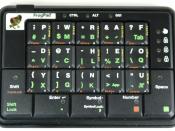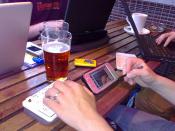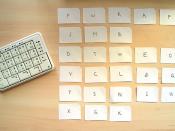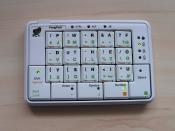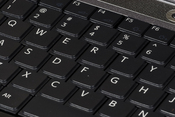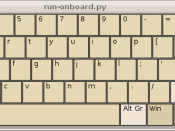An alternative to the orthodox computer keyboard dubbed the "QWERTY" keyboard has been long sought after. The "FrogPad" seems to offer the solution for many of the cutting edge computer company's hunt for a replacement. Currently available at price quotes of about $170.00, has even receive acclaim and encouragement from Doug Engelbart, the inventor of the computer mouse. Although change and having to learn new techniques are often not easily accepted by the public, the "FrogPad" seems to outweigh these disadvantages with its many beneficial attributes that caters to a wide range of the public.
The design of the "FrogPad" keyboard was developed by acquiring information from various sources to create a better user acceptance to its distinct format. The locations of the keys were a result of analyzing popular typing behaviors, and composing the keys to better accommodate them. By also researching human anthropology the "FrogPad" is more proficient at creating a design intended to maximize productivity by reducing operator fatigue and discomfort.
By making the "FrogPad" conform better to general typing styles and to the human hand users are more likely to accept the contemporary device.
The "FrogPad" has taken the standard dimensions of a keyboard that averages at more than a foot long and half of a foot wide to a humble three inches by five inches. By reducing the keyboard's amount by almost half the original size, computer users are left with an abundant more amount of territory on their computer desktops. The "FrogPad" accommodates 20 keys versus the standard 128 keys that computer users are use to. The dimension compression is achievable by combining one of the centrally located 15 keys with one of the 5 shift keys positioned at the bottom of the keyboard. The five shift keys enable the keyboard to create case, numbers, and even symbols. By limiting the keyboard size to its bear essential size, the "FrogPad" has attracted many consumers with the new evolution of keyboards.
One of the biggest concerns of the "FrogPad" company was the how hard will it be for users to learn how use the new form of typing. Tests done at Rice University demonstrated that it was seemingly effortless for the students to adapt to the keyboard's radical new format. The results showed that within the first eight to ten hours of learning, students were able to execute a 40 words a minute typing speed. "FrogPad" has proven to be not only convenient, but efficiently learned.
"FrogPad's" small size enables users to now type with one hand. This being an accomplishment all in itself, also has extra advantages. Users such as CAD and gamers are now able to keep one hand on the mouse at all times, an operation that is almost impossible with the standard keyboard. "FrogPad" has now created a better relationship for the two most commonly used computer peripheral devices, the mouse and the keyboard, for users.
The refreshed keyboard, "FrogPad", has also opened its new design to better suit disabled computer users who were once neglected by the computer industry. Disable users have found more leisure and quicker acceptance to "FrogPad's" unique design. Being aware of the disable population of users has made "FrogPad" more available to more of the world's computer users.
"FrogPad" has and undoubtedly place in the future and is manifesting itself as the new default keyboard for computer users. The company has even started planning for its future by teaming up with Gennum, a Canadian company, to help incorporate Bluetooth technology with its probationary name "Blue Frog." With its current advantages and its future adaptations "FrogPad" has a firm webbed-foot in the computer industry's future.
